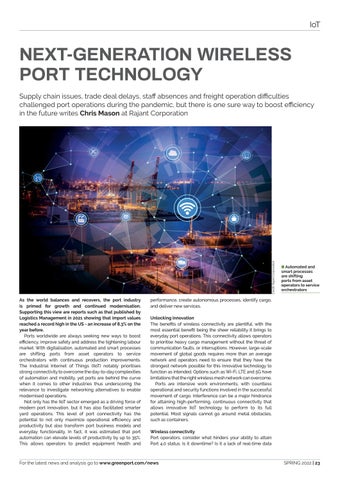IoT
NEXT-GENERATION WIRELESS PORT TECHNOLOGY
Credit: Rajant Corporation
Supply chain issues, trade deal delays, staff absences and freight operation difficulties challenged port operations during the pandemic, but there is one sure way to boost efficiency in the future writes Chris Mason at Rajant Corporation
As the world balances and recovers, the port industry is primed for growth and continued modernisation. Supporting this view are reports such as that published by Logistics Management in 2021 showing that import values reached a record high in the US - an increase of 8.3% on the year before. Ports worldwide are always seeking new ways to boost efficiency, improve safety and address the tightening labour market. With digitalisation, automated and smart processes are shifting ports from asset operators to service orchestrators with continuous production improvements. The Industrial Internet of Things (IIoT) notably prioritises strong connectivity to overcome the day-to-day complexities of automation and mobility, yet ports are behind the curve when it comes to other industries thus underscoring the relevance to investigate networking alternatives to enable modernised operations. Not only has the IIoT sector emerged as a driving force of modern port innovation, but it has also facilitated smarter yard operations. This level of port connectivity has the potential to not only maximize operational efficiency and productivity but also transform port business models and everyday functionality. In fact, it was estimated that port automation can elevate levels of productivity by up to 35%. This allows operators to predict equipment health and
8 Automated and smart processes are shifting ports from asset operators to service orchestrators
performance, create autonomous processes, identify cargo, and deliver new services. Unlocking innovation The benefits of wireless connectivity are plentiful, with the most essential benefit being the sheer reliability it brings to everyday port operations. This connectivity allows operators to prioritise heavy cargo management without the threat of communication faults, or interruptions. However, large-scale movement of global goods requires more than an average network and operators need to ensure that they have the strongest network possible for this innovative technology to function as intended. Options such as Wi-Fi, LTE and 5G have limitations that the right wireless mesh network can overcome. Ports are intensive work environments, with countless operational and security functions involved in the successful movement of cargo. Interference can be a major hindrance for attaining high-performing, continuous connectivity that allows innovative IIoT technology to perform to its full potential. Most signals cannot go around metal obstacles, such as containers. Wireless connectivity Port operators, consider what hinders your ability to attain Port 4.0 status. Is it downtime? Is it a lack of real-time data
For the latest news and analysis go to www.greenport.com/news
SPRING 2022 | 23







